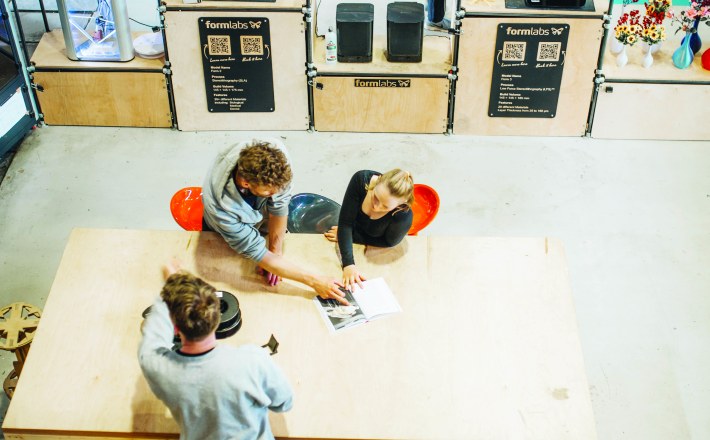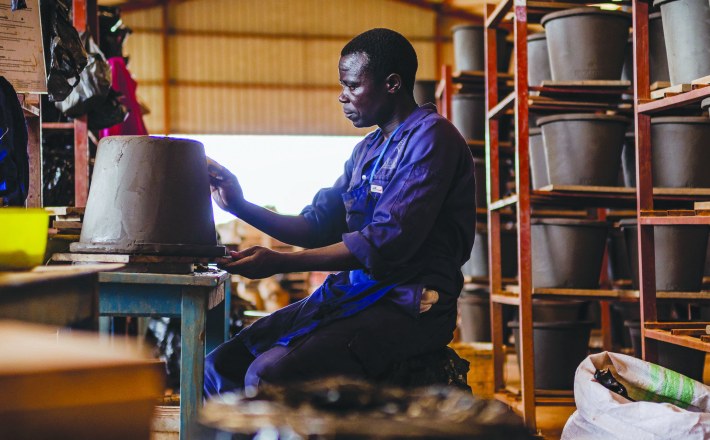The Art of Dreaming
Much of Pauline Beaudemont’s artistic practice takes place in her sleep. Situating herself within the discipline of post-surrealism, the French-born globetrotter channels the hidden truths of her subconscious through dream journals, experimental drawing techniques, and by giving herself the space to slow down, read, and connect ideas. These actions were next set to play out during a summer residency at the 25hours Hotel Langstrasse Zürich, which due to the pandemic has now been postponed indefinitely. Intrigued to hear what’s been keeping Beaudemont inspired, COMPANION gave the artist a call to chat about feminist superheroes, her current reading list, and the specific challenges the post-pandemic art world is likely to pose for women.
Growing up in the cultural epicentre of Paris, Pauline Beaudemont was surrounded by art from a young age. Having spent the weekends of her youth exploring galleries and museums, Beaudemont describes the French capital’s myriad cultural venues as her childhood playground. But it is, in fact, her early experiences at bible class that she credits with inspiring her to express herself visually. She recalls being asked to produce a collage of the three wise men to prove she’d understood the story. At the time, her architect father was working on building a museum in Morocco, and provided her with a variety of papers and images from the project. “I had so much fun doing it. Even as a six-year-old, I loved being able to put my own vision down on paper. I thought it was a great way to express myself and show others how I understood the world.”
I thought it was a great way to express myself and show others how I understood the world.
Pauline Beaudemont
Despite her early introduction to the worlds of creativity and self-expression, Beaudemont didn’t decide to pursue a full-time career as a visual artist until her late twenties. Training first as a photographer due to economic pressures, she completed her MA in Fine Arts aged 29 at the Haute École d’Arts Appliqués (HEAD) in Geneva. Since then, she has worked across a variety of mediums ranging from concrete sculpture to film, making it impossible to pin her to one particular discipline. “My work is very conceptual, and more a question of translating my inner thoughts, feelings, emotions, and vision into art rather than staying true to one specific medium,” she explains. That being said, Beaudemont’s nomadic lifestyle has more recently led her towards producing paintings and collages — many of which she’s posted on her Instagram and contrast images of nude male and female body parts with ancient, pre-Columbian artefacts—that are easier to transport when moving constantly between countries.

To date, Beaudemont has lived and worked in Berlin, Rome, Basel, and New York—where she set up her first artist space, Pauline’s, in a former Jewish grocery store in Brooklyn—and most recently, Mexico City. “When I first visited around five years ago, I knew it was a city I could live in,” says Beaudemont, who now spends around two to three months a year there, and has spent the coronavirus crisis self-isolating in the small village of Chacahua in Oaxaca. “It combines the atmospheres of all the cities I’ve been to: the delicacy of Paris, the energy of New York, and the artistic vibe of Berlin. Last year, when I had a studio here, work and ideas came so easily. I felt so energetic, like I could do anything I wanted,” she adds. This sense of freedom contrasts to the other places she’s called home. “There’s no judgement in creation in Mexico. The mentality in Europe among many of my friends is that if you do things aside from art, you’re not an artist. In Mexico, every day is different. You can be an artist, own a restaurant, or run a honeycomb company if you want to!”
You can be an artist, own a restaurant, or run a honeycomb company if you want to!
Pauline Beaudemont
A self-proclaimed post-surrealist —“people hate it when I say that because they think it’s totally uncool!”— who cites Meret Oppenheim as her “master”, Beaudemont is a firm believer in the power of the subconscious. “I’m training myself to be more in touch with my inner self,” she says, referencing methods she uses to do so, such as automatic drawing, a technique developed by the surrealist movement in which the artist suppresses conscious control over the making process: “I completely let myself go, and then just draw whatever comes to mind.” Beaudemont also writes down her dreams every morning, calling them the fuel of her art. “Last night I dreamt about watering can-like drones that were flying around over people's heads, providing everyone with their own, personal cooling mists. I was probably very hot,” she recalls, laughing.
By placing such importance on the subliminal, Beaudemont sometimes feels like she’s “just a body that produces things. Yes, I have to make conscious technical decisions sometimes, but other than that, everything is very instinctive. I’m just a vessel that everything passes through.” While this may seem like she doesn’t have to put in much active thought to create her art, she stresses that the subconscious is like a machine that you constantly need to feed by observing the world around you. “I spend most of my days reading,” she says. “I read a lot of poetry, detective novels, and essays about art, because it’s important to get to know your field. But as a child, I spent a lot of time working my way through Russian, French, and Japanese classics.” Recent titles she’s devoured include a biography of renowned American dance pioneer Isadora Duncan, and Nietzsche’s novel Thus Spoke Zarathustra.

Messages from Beaudemont’s subconscious are translated into her work in various ways, either as inspirations for drawings, paintings, and collages, or as written text. Two years ago at the Swiss Art Awards in Basel, for example, she exhibited a series of long white curtains printed with winding sentences taken from her dream journals. With phrases ranging from “she would paint her ears like you would paint your lips with red lipstick, to “her breasts were heavy and her nipples looked like two little phalluses,” each sentence’s curvature on the curtain seemingly reflects its meaning.
Although Dreams was to be the inspiration for Beaudemont’s residency with 25hours Hotel Langstrasse Zürich (originally scheduled for Summer 2020), it has since been postponed indefinitely due to the pandemic. The 25hours Hotels residency program ran from April 2017 until September of 2019, and has so far provided 13 international artists with an on-site workspace for 2-4 weeks at a time—to prepare for exhibitions, presentations, or future projects. At the end of their stay, each artist was asked to leave behind an artwork to be displayed in the hotel. “I first met Pauline in 2019, while she was doing a different residency in Zürich,” says Swiss artist Esther Eppstein, the residency program’s curator. “She came across as the kind of artist who dives into the art scene of whichever city she finds herself in, really wants to get to know people. This was an important factor in selecting Beaudemont for the residency. “I’m really interested in how this program can cultivate long-lasting relationships in Zurich’s art scene, and what future collaborations may arise from it.”
I’m really interested in how this program can cultivate long-lasting relationships in Zurich’s art scene, and what future collaborations may arise from it.
Pauline Beaudemont
Collaboration would have played a central role in Beaudemont’s residency. She had hoped to invite international creatives from various disciplines—including a musician, a lecturer, an artist, a tourist guide, and a performer—to spend a night with her in Zürich, exploring the topics of sleep and dreams through their respective art forms. The experience would have culminated in a book on sleep displaying the materials, texts, films, and music produced through these interactions. While the option of creating an e-book might have suggested that Beaudemont may have been able to conduct the residency remotely, even during the pandemic, she is resolute that being able to stay at 25hours Hotel Langstrasse Zürich would be paramount to her research. “It has to be in a hotel—they have such a different kind of energy,” she explains. “I have the most amazing dreams when I stay in hotels.”
The pandemic has not only affected Beaudemont’s residency, but the entire art world in general. While previously closed galleries may be reopening across Europe, many fairs, biennales, and exhibitions have been moved online or postponed indefinitely. Conversations around creating a more environmentally-friendly art world can only be viewed as positive, but, according to Beaudemont, women artists are going to face increased challenges post-pandemic.
“The art industry is male-dominated anyway; people just seem to think women aren’t very good artists,” she says, incredulously. She is, of course, referencing the fact that historical bias of art history, galleries, and museums towards the work of male artists. The feminist, activist art group The Guerrila Girls famously called out this bias in 1989, with their poster asking “Do women have to be nude to get into the Met. Museum?” and claiming that although fewer than 5% of artists displayed in the gallery were female, 85% of the nudes were depictions of women. Ever since, the movement campaigning for greater recognition for contemporary and historical women artists has gained momentum, with increasing numbers of institutions pledging to diversify their collections. The Tate Modern in London, for example, dedicated their permanent exhibition space to female artists for the duration of 2019—and podcasts such as The Great Women Artists and Bow Down: Women in Art by Frieze Magazine highlight the work of creatives from the past who deserve greater recognition. Despite this progress, Beaudemont believes that the coronavirus is going to be a big setback. “After the pandemic is over, I want to focus on supporting other female artists. We’re going to have to rely on each other,” she says.

Beaudemont has explored questions of gender and feminism throughout her career. She was particularly inspired when she discovered she was related to the Chevalier d'EÉon, a French transgender spy and diplomat operating during the reign of Louis XV. “I’ve always been interested in people who exist in between genders. Ever since I was a little girl, I’ve felt like I have both stereotypically masculine and feminine traits, so discovering my link to the Chevalier almost felt like a personal epiphany,” she explains. Then, “when I was living in Rome,”—Beaudemont completed a year-long residency at the Swiss Institute in the Italian capital between 2016-18—“I decided to create an alternate persona and transform into a feminist superhero,” she says. Named Artemis Fontana, her alter ego was a homage to two of the first Italian female painters of the Renaissance to be considered equal to men: Artemisia Gentileschi and Lavinia Fontana. Signing all her work under this name allowed her to discuss feminist issues undercover. “It was like being another version of myself,” she explains, referencing a series of grotesque sculptures she created of the male anatomy.
When she left Rome, Beaudemont decided to repurpose her pseudonym as the name for her own gallery in Paris, which she claims is the only exhibition space run by a solo female artist in the whole city. “No other galleries had a name like Artemis Fontana when I started up in 2018. They were all very serious,” says Beaudemont. “I like the fact that it sounds a little bit old fashioned, like a Roman gallery from 20 years ago that has come to Paris, completely broke, and is trying to start something new.” It’s not just the gallery’s name that sets it apart, however. Situated in a former sweatshop in the French capital’s 11th arrondissement, the interior is run-down, with exposed pipes, faded paintwork, and loose wires hanging from the ceiling. It’s a far cry from what one may expect from a sophisticated Parisian gallery. “Paris can be quite a snobby city, where everything is about money and power,” says Beaudemont. But while art often needs and deserves to be well-funded, necessity, as they say, is the mother of invention. In this respect, this artist is perfectly equipped to take on the challenges of the post-pandemic world: “I believe that you can do great things with no money in a very simple, genuine way.”




